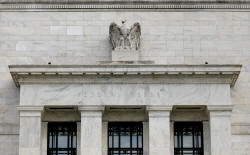Inflation, wage data, challenge Fed 'transitory' narrative
 Send a link to a friend
Send a link to a friend
[November 01, 2021] By
Howard Schneider
WASHINGTON (Reuters) - Price and wage increases running at
multi-decade highs may challenge Federal Reserve officials this week as
they try to maintain a balance between ensuring inflation remains
contained and giving the economy as much time as possible to restore the
jobs lost since the pandemic.
With investors already wagering the Fed will raise rates twice next
year, a much sooner and faster pace than policymakers themselves have
projected, economists at Goldman Sachs have become the latest to
accelerate their rate hike call - moving it ahead a full year to July
2022.
By then, Goldman economist Jan Hatzius and others wrote that they expect
inflation as measured by the closely monitored core personal consumption
expenditures price index, still to be above 3% - a run of inflation not
seen since the early 1990s and one well above the Fed's 2% target.
Aspects of the job market, particularly the labor force participation
rate, are unlikely to have recovered to pre-pandemic levels, and would
seemingly still be short of the "maximum employment" the Fed has
promised to restore before raising interest rates. But at that point,
the Goldman team wrote, Fed officials would "conclude that most if not
all of the remaining weakness in labor force participation is structural
or voluntary," and proceed with rate hikes to be sure inflation remains
controlled.
"Since the (Federal Open Market Committee) last met in September, the
unemployment rate has fallen further
https://www.reuters.com/world/
us/us-job-growth-slows-sharply-september-unemployment-rate-falls-48-2021-10-08,
average hourly earnings and the employment cost index have posted strong
increases
https://www.reuters.com/
article/
idCAKBN2HJ1N8?edition-redirect=ca, inflation has remained high," they
wrote, challenging the Fed's narrative that inflation will pass on its
own without using a rate increase to tighten credit conditions and slow
business and household purchases.
COLLAPSING TIMETABLE
The Fed meets this week and will issue a new policy statement on
Wednesday at 2 p.m. (1800 GMT), with a press conference following at
2:30 p.m. (1830 GMT) by Fed Chair Jerome Powell. Officials are expected
to approve plans for scaling back their current $120 billion in monthly
bond purchases that would phase them out completely by the middle of
next year - a first step away from the core policies put in place in
early 2021 to battle the economic fallout from the pandemic.
Fed officials have tried to separate that decision from their eventual,
and more consequential, call on when to raise interest rates. The
benchmark for a rate hike was established last year when the Fed said
its policy interest rate would not be increased until the economy had
returned to maximum employment, and "inflation has risen to 2 percent
and is on track to moderately exceed 2 percent for some time."
At the time, policymakers thought they would have ample time to
eventually phase out the bond purchases with little risk of inflation.
Even as prices started to accelerate earlier this year Fed officials
argued the high pace would prove "transitory" and not rush them into a
rate hike.
[to top of second column] |

Federal Reserve building
is pictured in Washington, DC, U.S., August 22, 2018. REUTERS/Chris
Wattie/File Photo
The timetable, however, may be collapsing on them.
Goldman economists now see a "seamless" handoff from the bond taper to rate
increases next year, a view that parallels the view now prevailing in interest
rate futures markets.
According to the CME Group's FedWatch
https://www.cmegroup.com/trading/
interest-rates/countdown-to-fomc.html tool, trading in federal funds futures
contracts now implies a greater than 65% probability that the Fed will raise
rates in June, right as the taper is expected to end, with a second increase
expected in November. A month ago, rates market indicators signaled less than a
20% likelihood of a rate hike as early June and an comparably negligible
probability for two hikes next year.
TRANSITORY THESIS 'NOT AGED WELL'
It may be a confusing moment when it comes to inflation. Blamed at first on what
were expected to be temporary supply disruptions and a bulge of consumer
spending on goods that were becoming hard to find in some cases, the pace of
price hikes has remained higher for longer than expected.
Goods inflation is not only expected to ease next year, but actually reverse in
a round of falling prices. But the cost of services is expected to make up the
difference, and particularly if a recent jump in employee compensation proves
persistent.
The rise in wages and benefits will present a particular challenge to the
central bank to determine if employees are getting paid better because
productivity is rising, or because job markets and the numbers of available
workers have been thrown out of synch by the pandemic.
One would be seen as a positive development; the other as potentially raising
inflation risks even higher.
"All this puts Powell in the hot seat at the November meeting to a much greater
extent than seemed likely even a few weeks ago," as he tried to balance a
committee roughly evenly split between those ready to raise rates next year and
those ready to show more patience, wrote Evercore ISI vice chair Krishna Guha.
"None of this proves that the transitory thesis will ultimately be wrong," he
wrote, but the "tests for believing that excess inflation will likely prove
transitory have not aged well."
(Reporting by Howard Schneider; Editing by Dan Burns and Daniel Wallis)
[© 2021 Thomson Reuters. All rights
reserved.] Copyright 2021 Reuters. All rights reserved. This material may not be published,
broadcast, rewritten or redistributed.
Thompson Reuters is solely responsible for this content. |